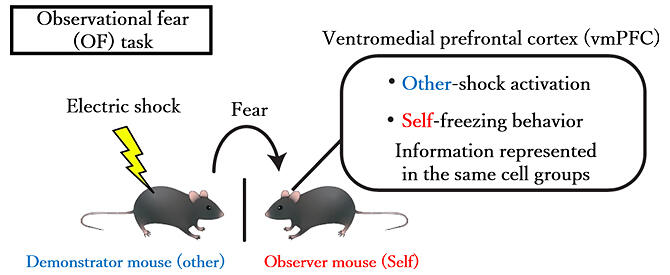A research group including Associate Professor Teruhiro Okuyama of the Institute of Quantitative Biosciences (IQB) at the University of Tokyo, graduate students Ziyan Huang and Myung Chung of the Graduate School of Medicine at the same university, and their colleagues have announced that the ventromedial prefrontal cortex (vmPFC) of the brain is involved in empathizing with the fear of others and that there are two types of neurons within this region that combine information of an individual's own and fear held by others. A new behavioral analysis system has been developed that can comprehensively and automatically classify different fear responses in mice. These results were obtained by observing the activity of neurons during behavioral experiments. The results are expected to lead to a better understanding of and drug development for autism spectrum disorder (ASD) associated with empathy difficulties. The results have been published in the 03 July 2023 issue of the international journal Nature Communications.

Provided by the University of Tokyo
The phenomenon in which similar emotions are transmitted simply by seeing someone who is sad or afraid is called emotional contagion and is considered the most core phenomenon of empathy. This has been observed not only in humans but also in social animals such as mice. The neural mechanisms of emotional contagion have been studied in mice in 'observational fear behavior experiments.'
In this experiment, two mice were placed in cages where they could see each other through a glass, and when one of them (the "other" mouse) was given an electric shock, both mice exhibited 'freezing behavior' as a fear response. That is, emotional contagion occurred between the demonstrator (shocked) mouse and the observer (unshocked) mouse.
Analysis of the neural mechanisms involved in this process revealed that the anterior cingulate cortex (ACC) associated with pain perception and the basolateral amygdala (BLA) of the emotional center were involved in emotional contagion and that the vmPFC may play an important role in the process of fear empathy. A direct neural input from the ACC and BLA to the vmPFC was also found. However, the role of the neural input to the vmPFC was unclear.
Due to this, the research group aimed to clarify the unknown neural mechanism of emotional contagion by analyzing not only the conventional response of 'freezing behavior' but also various other fear responses.
First, an experimental system was set up to analyze the different fear responses of the observed mice. Using deep learning, a system that can automatically track and classify 13 locations, including the animal's ears and tail, and automatically measure the mouse's behavior, was built. In addition to 'freezing behavior,' several other fear responses, such as escape behavior, have been recorded.
To clarify the role of the vmPFC in emotional contagion using the same system, vmPFC function was inhibited using an optogenetic method in observed mice during observational fear behavior. As a result, 'freezing behavior' was not decreased, but 'behavior of observing other mouse that is feeling fear' increased and 'escape behavior' decreased. Suppression of neural input from the ACC and BLA to the vmPFC increased escape behavior. In addition, neuronal activity in the vmPFC during emotional contagion was investigated by calcium imaging using a brain endoscope.
The results showed that there are two overlapping types of neurons in the vmPFC: those that increase in activity in response to the partner's fear and those that decrease. The existence of neurons that simultaneously convey information about 'one's own emotions' and 'those of others' has been revealed.
Okuyama said, "We expect this research to lead to a better understanding of ASD. We have already begun experiments and hope to identify new neural circuits involved in the pathology of ASD and to develop novel therapeutic strategies using mouse models of autism in the experimental behavioral system we have developed."
Journal Information
Publication: Nature Communications
Title: Ventromedial prefrontal neurons represent self-states shaped by vicarious fear in male mice
DOI: 10.1038/s41467-023-39081-5
This article has been translated by JST with permission from The Science News Ltd. (https://sci-news.co.jp/). Unauthorized reproduction of the article and photographs is prohibited.




